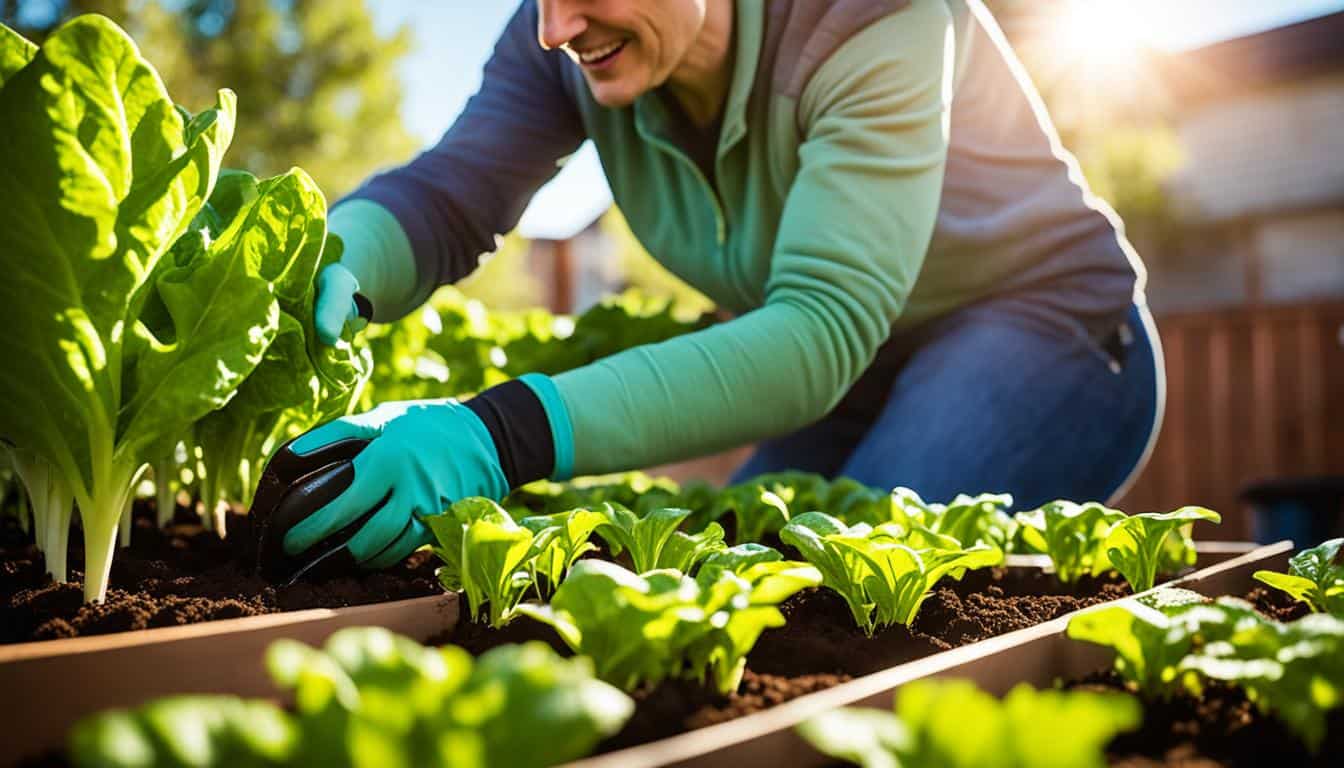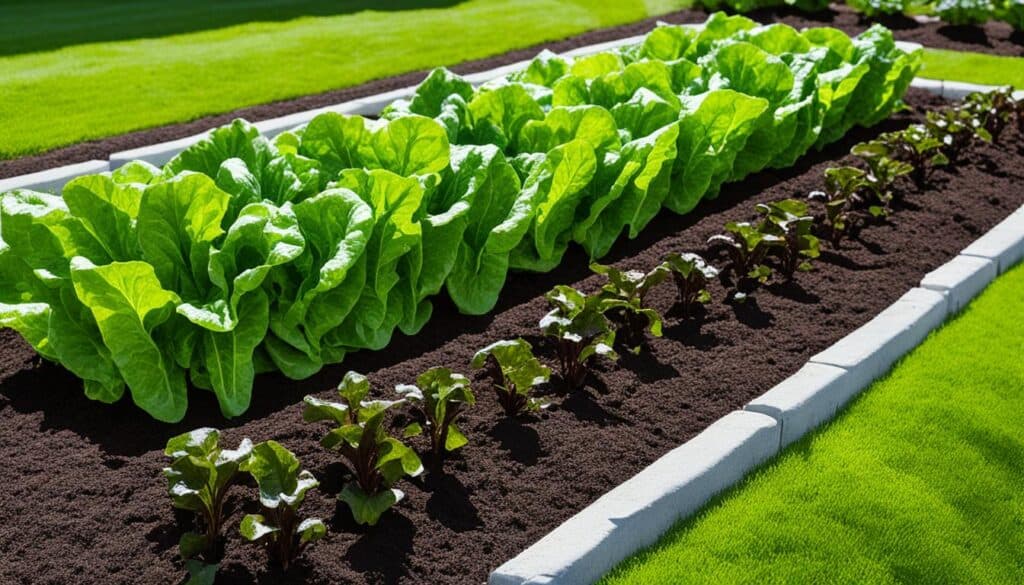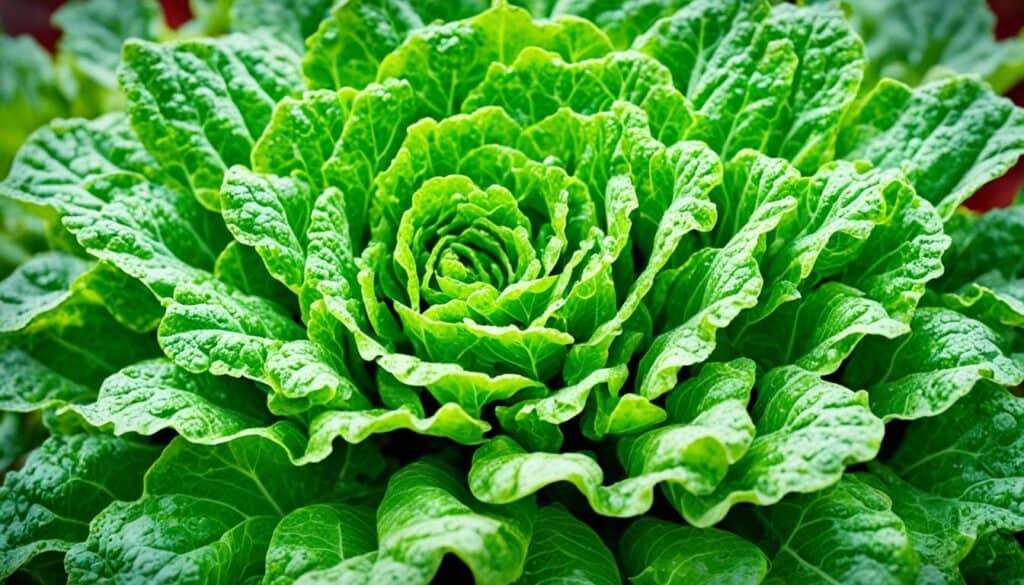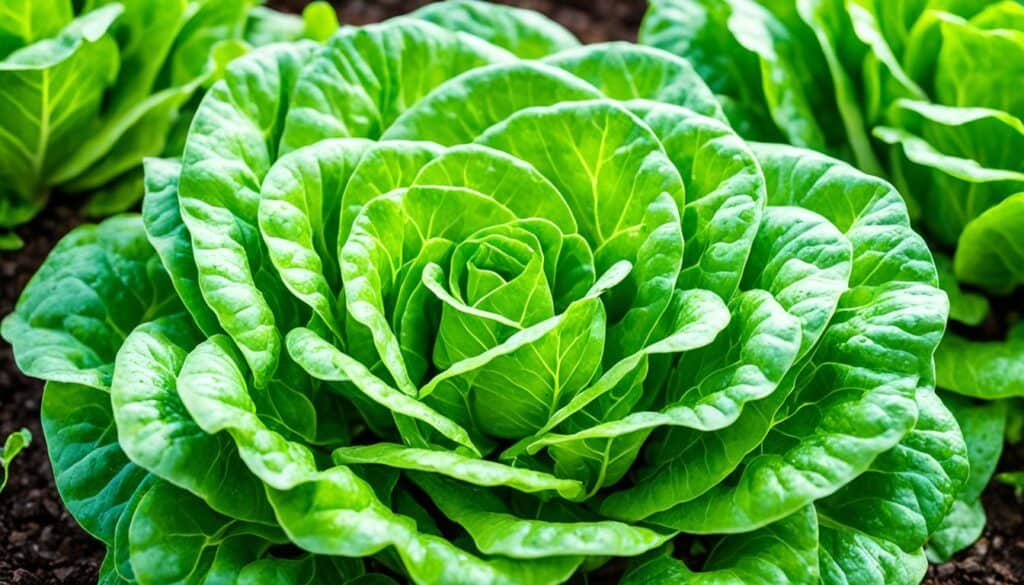Did you know that Boston lettuce is not only delicious but also incredibly nutritious? With its tender leaves and subtle flavor, it’s no wonder that this variety of lettuce is a favorite among salad enthusiasts.
Whether you’re a seasoned gardener or a beginner looking to try your hand at growing your own greens, this comprehensive guide will provide you with all the information you need to successfully plant, grow, and harvest fresh boston lettuce.
Key Takeaways:
- Boston lettuce is a versatile and nutritious salad vegetable.
- This guide will help you plant, grow, and harvest your own boston lettuce.
- Get ready to enjoy the satisfaction of homegrown, fresh, and organic boston lettuce.
- Discover the benefits of boston lettuce and explore delicious recipes.
- Take your salads to the next level with the flavorful and crunchy boston lettuce.
About Boston Lettuce
Boston lettuce is a type of lettuce that is grown for its luscious leaves. It belongs to the hearting and loose-leaf varieties of lettuce. Hearting lettuces include creamy butterhead types, upright romaine and cos lettuces, and the classic crunchy iceberg. Looseleaf lettuces can be harvested whole or a few leaves at a time, and come in a variety of types such as salad bowl lettuce and oakleaf lettuce.
Boston Lettuce Varieties
| Variety | Description |
|---|---|
| Butterhead Lettuce | A creamy and delicate lettuce with tender leaves that form loose heads. |
| Romaine Lettuce | An upright lettuce with long, sturdy leaves and a slightly bitter taste. |
| Iceberg Lettuce | A crisp and crunchy lettuce with tightly packed leaves and a mild flavor. |
| Looseleaf Lettuce | A lettuce with loosely arranged leaves that can be harvested individually. |
| Oakleaf Lettuce | A lettuce with deeply lobed leaves that resemble oak leaves. |
Benefits of Boston Lettuce
- High in vitamins A and C, which are important for immune health.
- Contains dietary fiber, which aids in digestion.
- Low in calories, making it a great choice for weight management.
- Provides hydration as it has a high water content.
- Can be a source of antioxidants, which help protect against cellular damage.
Boston Lettuce Recipe Idea
“Try this refreshing Boston lettuce salad with ripe tomatoes, crisp cucumbers, and a tangy vinaigrette dressing. It’s the perfect side dish for any summer meal!”
With its variety of types and delicious taste, Boston lettuce is a great addition to any salad or sandwich. Its versatile nature and ability to enhance the flavor of various dishes make it a favorite among salad lovers. Whether you’re looking for a tender and creamy texture or a crispy and refreshing bite, Boston lettuce has a variety that will suit your taste buds.
Planting Boston Lettuce
When it comes to growing boston lettuce, proper planting techniques are key. This cool-season crop can be successfully cultivated in most regions during the spring and fall, making it a versatile addition to any garden. Whether you have a spacious backyard or a compact balcony, boston lettuce can thrive in various settings, including raised beds and containers, providing you with an abundant harvest of fresh greens.
If you choose to plant boston lettuce directly in the soil, it should be done as soon as the ground can be worked. The seeds can be directly sown into well-prepared soil, following the recommended spacing guidelines for each variety. Alternatively, you can opt for transplanting small seedlings into the ground to give your plants a head start.
Raised beds and containers are particularly beneficial for growing boston lettuce. They offer excellent drainage, which is crucial for maintaining healthy root systems, and they are also suitable for small spaces, making them perfect for urban gardening enthusiasts. By utilizing raised beds and containers, you can have greater control over the quality of the soil and optimize the growing conditions for your lettuce.
Before planting boston lettuce, it’s important to consider the soil temperatures. The ideal range for successful germination and growth is between 45°F and 65°F. To ensure you’re planting at the right time, consult a planting calendar specific to your region. This will help you determine the optimal dates for sowing or transplanting your boston lettuce for the best results.
By following these planting guidelines, you can establish a strong foundation for your boston lettuce crop. Whether you choose direct sowing or transplanting, and whether you opt for raised beds or containers, ensuring proper soil temperatures and adhering to a planting calendar will help set you up for a successful harvest.
How to Plant Boston Lettuce
Growing your own boston lettuce can be a rewarding experience, and there are two common methods for planting: direct sowing and transplanting seedlings. Let’s explore each method in detail:
Direct Sowing
Direct sowing involves planting the lettuce seeds directly into the soil of your garden or container. Here are the steps to follow:
- Prepare the soil: Ensure the soil is loose, well-draining, and free from debris. Remove any weeds or rocks that may hinder the growth of your lettuce.
- Determine the seed depth: The depth at which you sow the seeds can impact their germination. For boston lettuce, plant the seeds 1/8 to 1/4 of an inch deep.
- Space the seeds: Depending on the type of lettuce, leave adequate space between the seeds to allow room for growth:
- Succession planting: To ensure a continuous harvest, consider planting new batches of seeds every 2 weeks. This will allow for staggered growth and consistent lettuce supply.
- Water the seeds: Gently water the seeded area to provide sufficient moisture for germination.
- Care for the seedlings: As the lettuce seedlings emerge, thin them out according to the recommended spacing to prevent overcrowding.
| Type of Lettuce | Spacing |
|---|---|
| Loose-leaf lettuce | 4 inches apart |
| Romaine and butterhead lettuce | 8 inches apart |
| Crisphead lettuce | 16 inches apart |
Transplanting Seedlings
If you prefer to start with young lettuce plants, you can transplant seedlings instead of sowing seeds. Here’s how:
- Prepare seedlings: Start seeds indoors or purchase young lettuce plants from a reputable garden center.
- Prepare the soil: Amend the soil with compost or organic matter to ensure it is fertile and well-draining.
- Transplanting process: Dig holes in the soil, spaced according to the recommended spacing for the specific lettuce variety. Gently remove the seedlings from their containers and place them in the holes. Firmly press the soil around the roots to secure the seedlings.
- Water the transplants: Give the transplanted seedlings a thorough watering to help them establish in their new environment.
Regardless of the planting method you choose, be sure to provide consistent moisture, sunlight, and care to ensure the success of your boston lettuce crop.
Let’s move on to the next section to learn about the best practices for growing your boston lettuce, including sunlight requirements, soil preparation, watering, mulching, weeding, and preventing bolting.
Growing Boston Lettuce
When it comes to growing boston lettuce, there are a few key factors to consider. Let’s explore the sun requirements, soil preparation, watering, mulching, weeding, and methods to prevent bolting.
Sun Requirements
Boston lettuce thrives when exposed to 5 to 6 hours of sunlight each day. It’s important to choose a suitable location in your garden that provides the necessary amount of sun exposure for optimal growth.
Soil Preparation
The soil for boston lettuce should be loose, well-draining, and moist but not soggy. Prior to planting, it’s recommended to prepare the soil by removing any weeds, rocks, or debris and incorporating organic matter such as compost or well-rotted manure to improve its fertility and structure.
Watering
Consistent watering is crucial for boston lettuce as it prefers a well-hydrated environment. Keep the soil evenly moist by providing a regular water supply. Avoid overwatering, as it can lead to waterlogged conditions and promote diseases.
Mulching
Mulching the soil around the lettuce plants can help conserve moisture, regulate soil temperature, and suppress weed growth. Apply a layer of organic mulch, such as straw or shredded leaves, around the plants, ensuring to leave a small gap around the base to prevent rotting.
Weeding
Weeds compete with boston lettuce for nutrients, water, and sunlight. It’s important to regularly remove weeds from the garden bed to prevent them from stealing valuable resources from your lettuce plants. Use hand-weeding methods to avoid damaging the shallow roots of the lettuce plants.
Preventing Bolting
Bolting, the production of a central stem and seed stalk, can negatively affect the quality and taste of boston lettuce. To prevent bolting, provide shade to the lettuce plants during hot periods of the day, such as using shade cloth or planting them near taller crops that provide partial shade. Consistent watering also helps to delay bolting.
| Aspect of Growing | Key Considerations |
|---|---|
| Sun Requirements | 5-6 hours of sun each day |
| Soil Preparation | Loose, well-draining, and moist soil |
| Watering | Consistent and even moisture |
| Mulching | Helps conserve moisture and suppress weeds |
| Weeding | Regular removal of weeds to prevent competition |
| Preventing Bolting | Providing shade and consistent watering |
Lettuce Pests and Diseases
When growing boston lettuce, it’s important to be aware of the pests and diseases that can affect your plants. By taking preventative measures and implementing organic solutions, you can protect your lettuce and ensure a healthy harvest.
Pests
Aphids, deer, and slugs are the most common pests that can damage boston lettuce. Aphids are small insects that feed on the sap of lettuce plants, causing stunted growth and curling leaves. To control aphids, you can wash the leaves with water or use an organic soapy water spray.
Aphids can be controlled by washing the leaves and using organic soapy water spray.
Deer are known to graze on lettuce plants, leaving behind chewed leaves and damaged crops. To deter deer, you can use physical barriers like fences or employ organic methods such as diatomaceous earth, which creates an uncomfortable environment for these animals.
Deer can be deterred by using physical barriers or organic methods, such as diatomaceous earth.
Slugs are another common pest that can feast on boston lettuce, leaving behind holes in the leaves. To keep slugs at bay, you can set up beer traps or create barriers using materials like copper tape, which slugs are reluctant to cross.
Slugs can be deterred by using beer traps or barriers made of copper tape.
Diseases
Bolting is a common problem with boston lettuce, especially in warm temperatures. Bolting is when the lettuce plants produce a central stem and seed stalk instead of forming a full head. To prevent bolting, you can provide shade to the plants and ensure consistent watering.
Bolting, which is caused by warm temperatures, can be delayed by providing shade and consistent watering.
Fungal diseases can also affect boston lettuce, including downy mildew and powdery mildew. These diseases can cause white or gray powdery patches on the leaves, affecting their health and quality. To prevent fungal diseases, ensure proper air circulation around the plants, avoid overhead watering, and remove any infected leaves promptly.
Fungal diseases such as downy mildew and powdery mildew can be prevented by ensuring proper air circulation, avoiding overhead watering, and promptly removing infected leaves.
It’s essential to regularly inspect your boston lettuce plants for signs of pests or diseases. By taking proactive measures and addressing any issues promptly, you can safeguard your lettuce crop and enjoy a bountiful harvest.
Harvesting Boston Lettuce
Boston lettuce can be harvested in various ways depending on your preference. For those looking for tender and delicate leaves, harvesting baby greens is the way to go. Simply pick individual young leaves continuously as they reach the desired size. This method allows you to enjoy fresh boston lettuce throughout its growing season.
If you prefer larger leaves or heads of lettuce, you can selectively harvest the outer leaves as the plants grow. This method ensures that you have a steady supply of fresh boston lettuce while allowing the remaining leaves to continue growing. Alternatively, you can opt to cut off the entire head of lettuce, about an inch above the soil surface, for a complete harvest.
Another popular method of harvesting boston lettuce is the cut-and-come-again approach. This method involves harvesting a few leaves from each plant at a time, allowing the plants to continue growing and producing new leaves. It provides a continuous harvest of fresh boston lettuce for an extended period, making it an excellent choice for those who enjoy having lettuce available at all times.
| Harvest Method | Benefits |
|---|---|
| Harvesting baby greens | Tender and delicate leaves |
| Selective harvesting of outer leaves | Steady supply of fresh greens |
| Harvesting full heads | Complete harvest in one go |
| Cut-and-come-again harvesting | Continuous harvest for an extended period |
Experiment with different harvesting methods to find the one that suits your needs and preferences. Whether you prefer harvesting baby greens, outer leaves, or full heads, boston lettuce offers a delightful variety of options to enjoy in your salads, sandwiches, or as a crisp and refreshing snack.
Storing Boston Lettuce
When it comes to keeping your Boston lettuce fresh and crisp, proper storage is key. Follow these tips to ensure your boston lettuce stays delicious for as long as possible.
To start, place your harvested lettuce in a loose plastic bag. This will help to maintain its moisture while still allowing for some airflow. By storing the lettuce in a bag, you can prevent it from drying out or becoming too moist.
Keep your bag of lettuce in the refrigerator, where it can stay fresh for up to 10 days. The cool temperatures of the fridge will help slow down the wilting process and keep your lettuce leaves firm and crisp.
Before using the stored lettuce, it’s a good idea to give it a little extra care. Fill a bowl with cold water and soak the lettuce leaves for a few minutes. This will help to revive any slightly wilted leaves, making them crisp and fresh again.
Once you’ve soaked the lettuce, use a salad spinner or a clean towel to remove any excess water. This step is important, as excess moisture can cause the leaves to become soggy and wilted. By removing the water, you’ll help prolong the freshness of your boston lettuce.
By following these storing tips, you can enjoy the refreshing taste of your boston lettuce for longer, ensuring that every salad or wrap is as vibrant and delicious as possible.
Recommended Varieties of Boston Lettuce
When it comes to Boston lettuce, there are several recommended varieties that offer unique characteristics and flavor profiles. Whether you prefer the crunch of crisphead lettuce or the delicate leaves of butterhead, there is a variety to suit every taste and preference. Let’s take a closer look at some of the popular varieties of Boston lettuce:
Crisphead (Iceberg) Lettuce
The crisphead variety of Boston lettuce, also known as iceberg lettuce, is characterized by its dense and compact heads. It has a crisp texture and is mild and slightly sweet in flavor. Crisphead lettuce is perfect for those classic salads or as a crunchy addition to sandwiches and burgers.
Romaine (Cos) Lettuce
Romaine lettuce is another popular variety of Boston lettuce with elongated and upright heads. It has sturdy, dark green leaves with a slightly bitter taste. Romaine lettuce is commonly used in Caesar salads and adds a refreshing crunch to wraps and sandwiches.
Butterhead (Boston or Bibb) Lettuce
The butterhead variety of Boston lettuce is known for its soft, buttery leaves that form loose heads. It has a delicate texture and a mild, sweet flavor. Butterhead lettuce is great for salads, sandwiches, and wraps, adding a touch of elegance to your dishes.
Loose-Leaf Lettuce
Loose-leaf lettuce is an open and loose variety of Boston lettuce that doesn’t form a tight head. It has tender leaves that come in various colors, including green and red. Loose-leaf lettuce is versatile and can be used in salads, sandwiches, and wraps, providing a fresh and vibrant addition to your meals.
Red Leaf Lettuce
Red leaf lettuce is an eye-catching variety of Boston lettuce with beautiful, burgundy-colored leaves. It has a mild and slightly sweet flavor, adding both visual appeal and taste to your salads. Red leaf lettuce is often used as a base for salads or as a colorful garnish for various dishes.
By choosing from these diverse varieties of Boston lettuce, you can enhance your culinary creations with different flavors, textures, and colors. Whether you’re looking for a crisp and refreshing bite or a buttery and tender leaf, Boston lettuce has a variety to satisfy your salad cravings.
Tips for Growing Boston Lettuce
When it comes to growing Boston lettuce, there are a few key tips to keep in mind. By following these gardening tips, you’ll increase your chances of a successful lettuce harvest and enjoy fresh, crisp lettuce right from your garden.
1. Provide the Right Amount of Sunlight and Water
Boston lettuce thrives in cool conditions and requires 5 to 6 hours of sunlight per day. Find a spot in your garden that offers partial shade, especially during hotter parts of the day. Additionally, water your lettuce consistently, keeping the soil moist but not overly saturated.
2. Use Well-Draining and Fertile Soil
Boston lettuce prefers well-draining soil, as excessive moisture can cause root rot. Prepare your soil by adding organic matter such as compost or aged manure to improve drainage and fertility. Loamy soil with a pH of around 6.0 to 7.0 is ideal for growing healthy lettuce.
3. Practice Succession Planting for a Continuous Harvest
To enjoy a continuous supply of fresh lettuce, consider practicing succession planting. This involves sowing new seeds every couple of weeks to ensure a steady crop throughout the growing season. By staggered planting, you’ll have lettuce at different stages of growth, allowing for a prolonged harvest.
4. Protect the Lettuce from Pests and Diseases
Boston lettuce is susceptible to various pests and diseases, including aphids and fungal infections. To protect your lettuce, regularly inspect the plants for signs of damage and promptly address any issues. Consider implementing organic pest control methods and practicing proper crop rotation to minimize the risk of diseases.
5. Harvest the Lettuce at the Right Time
Knowing when to harvest your Boston lettuce is vital for optimal flavor and texture. Harvest loose-leaf varieties by plucking outer leaves as needed, allowing the center to continue growing. For heading varieties, wait until the heads are full and firm, then cut them off about an inch above the soil surface.
By following these simple gardening tips, you’ll have a flourishing Boston lettuce garden in no time. Enjoy the vibrant colors, tender leaves, and fresh taste of homegrown lettuce with your favorite salads and sandwiches.
Conclusion
Growing boston lettuce is a delightful and satisfying endeavor for any gardener. With this comprehensive growing guide and useful gardening tips, you can confidently cultivate this versatile salad favorite in your own backyard.
By following the step-by-step instructions, you’ll be able to plant boston lettuce successfully, whether you choose to start from seeds or transplant young seedlings. With the right amount of sunlight, well-drained soil, and consistent watering, your boston lettuce plants will thrive and produce the freshest greens.
When it’s time to harvest your bountiful crop, you’ll have the option to enjoy baby greens, selective leaf harvests, or full heads. Thanks to the wide variety of boston lettuce types available, from crisphead to butterhead, you can experiment with different flavors and textures in your salads and meals.
Don’t forget about proper storage to preserve the freshness of your harvested boston lettuce. Simply store the lettuce in a loose plastic bag in the refrigerator, and revive any wilted leaves with a quick soak in cold water. With these tips and techniques, you can savor the flavors of your homegrown boston lettuce for up to 10 days.










Leave a Reply